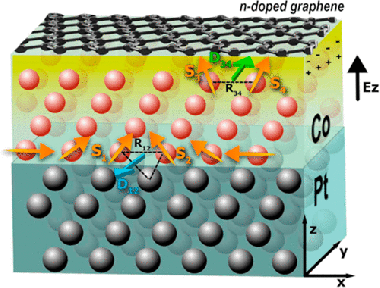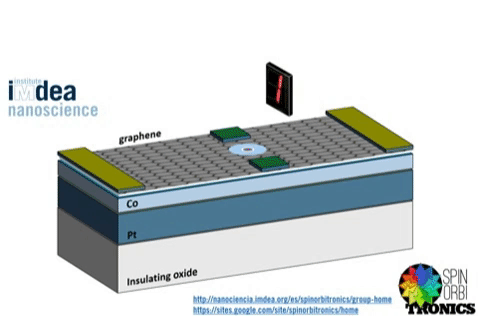
Graphene and cobalt for creating new electromagnetic devices
Researchers from IMDEA Nanociencia and other European centres have discovered that the combination of graphene with cobalt offers very relevant properties in the field of magnetism. This breakthrough sets the stage for the development of new logic devices that can store large data amounts quickly and with reduced energy consumption.

Diagram of stacked graphene, cobalt (Co) and platinum (Pt) layers with magnetic interaction vectors / Credit: Adrián Gudín, Paolo Perna, IMDEA Nanociencia (Nano Letters)
One of the latest technologies to digitally encode information is the 'spin-orbitronic', which not only exploits the charge of the electron (electronics) and its spin (spintronics), but also the interaction of the spin with its orbital motion, offering a multitude of properties that are relevant in magnetism.
This technology is applied in certain materials to generate magnetic configurations that are very stable but which can be controlled and moved quickly with very small electrical currents. The resulting structures are considered very promising for future 'spin-orbitronic' devices, as they provide high processing speed and a high capacity for storing data, with low energy consumption.
The device is made of graphene, cobalt and platinum layers and offers magnetic properties that allow the transport of binary information
Now, a European team led by the IMDEA Nanociencia Institute has developed a methodology to prepare one of these systems. This, more specifically, consists in a device made of stacked graphene films (a single atomic graphite layer) placed on ferromagnetic material: cobalt, arranged in turn on a platinum layer with a certain crystallographic orientation. The details are published in Nano Letters magazine.
The main author of the study, Paolo Perna, from IMDEA Nanociencia, explains the advantages of this configuration: “On the one hand, the exceptional properties of graphene make it possible to obtain a homogeneous, flat and protected magnetic layer, which is also atomically perfect.”
“However, what matters most,” he goes on to emphasize, “are the two magnetic properties that are achieved: an improvement in the magnetic anisotropy of cobalt (its spines are preferably oriented in a certain direction), and a strong interaction called Dzyaloshinskii-Moriya, which allows the presence of chiral magnetic structures (they do not overlap with its specular image).”
Skyrmions for carrying binary information
These chiral magnetic structures of nanometric size are called skyrmions, are very stable and act as carriers of binary information as they travel through the channel proposed by the authors: graphene. “By passing through two electrical contacts, each skyrmion produces a change in the electrical response that can be decoded into zeros and ones,” explains Perna.
“In this way, in the near future it will be possible to produce spin-orbitronic magnetic devices, such as magnetic memories or sensors that are much faster and denser than the current ones, and with much lower energy consumption,” the researcher stresses.
In the near future it will be possible to produce spin-orbitronic magnetic devices, such as magnetic memories or sensors, with much lower energy consumption
In order to detect the properties, the authors have used combined spectroscopy and microscopy techniques, including some with light at the ALBA synchrotron near Barcelona. Researchers from the Complutense and Autonomous Universities of Madrid, together with the Néel Institute of Grenoble (France), have also participated in the study.
As the basis of the device, the authors have used oxide insulating substrates. In order to obtain high-quality graphene, metallic substrates are usually used in laboratories, but they are very expensive for the industry and, as conductors, they would not allow the electrical insulation of the device with the chip.
“We have proven that it is feasible to prepare high quality magnetic structures based on graphene and on oxide insulating substrates, which can be implemented in current manufacturing processes,” Perna notes.
This work has been accomplished within the framework of the European Graphene Flagship initiative, as part of the SOgraphene Project, coordinated by Professor Rodolfo Miranda of IMDEA Nanociencia and involving Albert Fert, Nobel Prize in Physics, and his team from the Unité Mixte de Physique CNRS/THALES, as well as researchers from the SOLEIL synchrotron in France and the PM institute in Italy.
References:
Fernando Ajejas, Adrian Gudín, Ruben Guerrero, Alberto Anadón Barcelona, Jose Manuel Diez, Leticia de Melo Costa, Pablo Olleros, Miguel Angel Niño , Stefania Pizzini, Jan Vogel, Manuel Valvidares, Pierluigi Gargiani , Mariona Cabero, Maria Varela, Julio Camarero, Rodolfo Miranda and Paolo Perna. “Unraveling Dzyaloshinskii–Moriya Interaction and Chiral Nature of Graphene/Cobalt Interface”. Nano Letters 18 (9): 5364–5372, 2018. DOI: 10.1021/acs.nanolett.8b00878
SINC produces scientific news for the European project SCOPE, coordinated by FECYT and funded by the European Union through Horizon 2020, its funding program. The SCOPE mission is to communicate visionary research results of partnering projects in the framework of the Graphene Flagship and the Human Brain Project, as well as to enhance the FET Flagships partnering environment in the European Union.























No hay comentarios:
Publicar un comentario